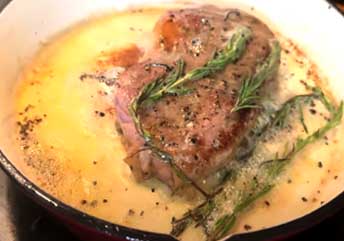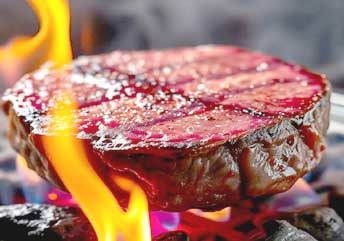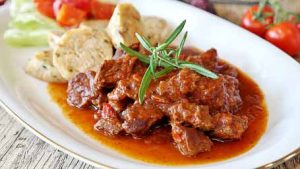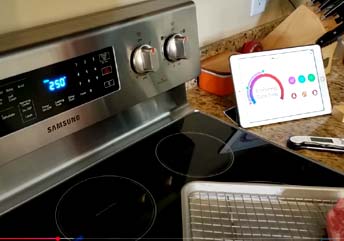This guide explains medium rare steak clearly. It answers safety questions like pregnancy concerns. You will master temperatures, cooking methods, and tips to enjoy perfect steak every time. Therefore, let’s start so you feel confident at your next barbecue.
Why Steak Doneness Matters: Safety, Texture, and Flavor
You choose doneness because it affects your meal’s safety first. Proper cooking kills harmful bacteria on the surface. However, overcooking dries out the steak. This ruins its juicy texture.
Moreover, flavor peaks at certain levels. Medium rare keeps fats melting for rich taste. Therefore, understanding doneness prevents foodborne illness.

Additionally, it enhances enjoyment. Different cuts like ribeye suit medium rare better than leaner ones. So, you balance health, mouthfeel, and deliciousness. Now, check the key reference that makes this easy.
The Steak Doneness Temperature Chart: Your Essential Reference
You rely on accurate temperatures to nail doneness. Therefore, use this chart based on 2025 guidelines. It shows internal temps in Fahrenheit and Celsius.
Moreover, remember to remove steak 5°F early. The meat cooks more while resting. Additionally, insert a thermometer in the thickest part. Avoid touching bone or fat.
Here is the table formatted for clarity and accuracy, incorporating the key principle that the steak’s temperature will continue to rise by 5-10°F (3-6°C) after being removed from the heat, known as “carryover cooking.”
| Doneness Level | Remove from Heat (°F/°C) | Final Temp After Rest (°F/°C) | Description |
|---|---|---|---|
| Blue Rare (Very Rare) | 80-100°F / 27-38°C | 90-105°F / 32-41°C | Cool, deep red center, barely warm; seared outside only. |
| Rare | 120-125°F / 49-52°C | 125-130°F / 52-54°C | Cool to warm red center; very soft and juicy. |
| Medium Rare | 130-135°F / 54-57°C | 135-140°F / 57-60°C | Warm red center; juicy, tender, and the most popular doneness. |
| Medium | 140-150°F / 60-66°C | 145-155°F / 63-68°C | Warm pink center; firmer but still moist. |
| Medium Well | 155-160°F / 68-71°C | 160-165°F / 71-74°C | Only a slight hint of pink; firm and mostly grey throughout. |
| Well Done | 160°F+ / 71°C+ | 165°F+ / 74°C+ | Little to no pink; fully firm and can be quite dry. |
Important Note: These temperatures are a guideline. The exact amount of carryover cooking depends on the steak’s thickness and the cooking method. Always use a reliable instant-read thermometer for the best results.
This chart helps you avoid guesswork. Therefore, invest in a good thermometer for precision. Now, see what each level looks like visually.
A Visual Guide to Every Steak Doneness Level
You spot doneness best with pictures. Therefore, this section shows clear images of each level. Moreover, compare colors and textures easily. Additionally, use these as references when cutting into your steak.
Blue Rare: What is a Blue Steak?
You achieve blue rare by searing quickly. The center stays cool and deep red, almost purple. Moreover, it feels very soft. However, few people choose this because it looks like raw meat. Therefore, cook to 80-100°F internally. See this image for the vivid color.
Rare Steak: The Cool Red Center
You get rare steak with a quick cook. The center remains cool and bright red, about 75% red throughout. Moreover, juices flow freely. Additionally, it offers tender texture. So, aim for 120-130°F. This level suits steak lovers who want minimal cooking.
What is a Medium Rare Steak? The Chef’s Favorite
You define medium rare steak as one with a warm red center. It reaches 130-135°F inside. Moreover, the outside sears firm while the inside stays juicy. Additionally, about 50% red center appears.
Therefore, chefs love it because it balances flavor and tenderness. However, ensure proper handling to kill surface bacteria. So, you enjoy rich taste without dryness. Furthermore, from different angles, the red gradients show clearly in photos.
Medium vs. Medium Rare Steak: Spot the Difference
You distinguish medium from medium rare easily with visuals. Medium rare shows a warm red center, while medium has a warm pink one. Moreover, medium rare feels more tender.
Additionally, flavor in medium rare bursts with juices, but medium offers firmer bite. Therefore, choose based on preference—medium rare at 130-135°F, medium at 135-145°F. This split image highlights the subtle color shift.
Medium Steak: The Warm Pink Meat
You cook medium steak to 135-145°F. The center turns warm pink with less red. Moreover, it provides balanced texture—not too soft or firm. Additionally, many families prefer this for safety. Therefore, it suits beginners avoiding underdone meat.
Medium Well Steak: Slightly Pink
You reach medium well at 145-155°F. A faint pink line appears in the center. Moreover, the steak firms up more. However, it still retains some moisture. Therefore, this level works for those wanting less pink without dryness.
Well Done Steak: Fully Cooked
You achieve well done above 160°F. No pink remains, and the center browns fully. Moreover, it feels very firm. However, juices reduce, making it drier. Therefore, use marinades to keep it tasty. Additionally, health guidelines often recommend this for certain groups.
These visuals make doneness clear. Therefore, practice with them to improve your skills. Now, learn how to cook medium rare perfectly.
How to Cook a Medium Rare Steak: Every Method Explained
You cook medium rare steak using various tools. Therefore, follow these steps for grill, oven, or air fryer. Moreover, times vary by thickness—use a thermometer always. Additionally, let steak reach room temp first for even cooking.
How to Grill a Medium Rare Steak
You preheat your grill to high, about 450-500°F. Season the steak simply with salt and pepper. Moreover, grill 4-5 minutes per side for 1-inch thick cuts.
Additionally, flip once and check at 130°F. Therefore, rest 5 minutes after. This method gives smoky flavor easily.
How to Cook a Medium Rare Steak in the Oven
You use reverse sear for oven success. Preheat to 275°F, then bake steak on a rack until 120°F inside, about 20-30 minutes. Moreover, sear in a hot pan 1 minute per side. Additionally, this ensures even doneness.
Therefore, you get tender results without a grill.
How to Cook a Medium Rare Steak in an Air Fryer
You set air fryer to 400°F. Place seasoned steak in basket for 8-12 minutes, flipping halfway. Moreover, aim for 130°F internal. Additionally, no oil needed for crisp sear. Therefore, this quick method suits busy nights.
These methods deliver perfect medium rare. Therefore, experiment to find your favorite. Now, address safety concerns directly.
Is Medium Rare Steak Safe? Crucial Safety Questions Answered
You question medium rare’s safety often. Therefore, understand bacteria focus on surfaces. Moreover, proper searing kills them. However, always buy fresh cuts from trusted sources.
Is Medium Rare Steak Safe to Eat?
You eat medium rare steak safely with whole muscle cuts. The inside stays sterile if handled right. Moreover, USDA approves 130°F for beef. Additionally, millions enjoy it without issues. Therefore, trust your thermometer and fresh meat.
Can You Eat Medium Rare Steak While Pregnant? A Doctor’s Advice
You avoid medium rare steak during pregnancy per guidelines. Official sources like USDA and CDC recommend 145°F minimum to kill potential pathogens. Moreover, risks include toxoplasmosis or listeria.
Even well-seared steaks pose slight dangers. Therefore, choose medium or well done at 160°F. However, consult your doctor for personal advice. So, prioritize baby’s health.
This section builds trust with facts. Therefore, you make informed choices. Now, learn a handy trick without tools.
The “Touch Test” for Doneness: A Pro Trick
You check doneness with your hand easily. Touch your thumb to fingers and poke the palm base. For medium rare, touch thumb to middle finger—the firmness matches. Moreover, rare feels like thumb to index. Additionally, practice builds accuracy. Therefore, use this when thermometers fail. However, combine with visuals for best results.
How to Reheat Steak to Perfect Medium Rare
You reheat steak without overcooking by using low heat. Place it in a 250°F oven on a rack until 110°F inside, about 20-30 minutes. Moreover, sear quickly in a hot pan after. Additionally, microwave in 30-second bursts on medium with a damp towel. Therefore, you restore juiciness. However, eat within two days for safety.
Frequently Asked Questions About Steak Doneness
You ask these questions often. Therefore, here are clear answers.
What is the red juice in a medium rare steak? Is it blood?
No, you see myoglobin, a protein—not blood. It mixes with water for pink juices. Moreover, it’s safe and adds flavor.
What is the safe internal temperature for medium rare steak?
You aim for 130-135°F. Moreover, rest raises it slightly.
Is medium rare steak safe for children?
You cook to medium for kids under 5, per CDC. Moreover, older children handle medium rare if fresh.
Why do chefs recommend medium rare?
Chefs prefer it because it maximizes tenderness and flavor. Moreover, overcooking toughens meat.
In summary, you now understand medium rare steak fully. Therefore, cook confidently and safely. What’s your favorite doneness? Share below—I respond to comments. For more tips, subscribe or check our spoilage guide.
Some Useful Resources about the Medium Rare Steak
An Video about Medium Rare Steak
Another Video about the Comparison of Medium Rare Vs Well Done Steak
Here is the last video about Cooking a Perfect Medium Rare Steak
As a reference here are some websites about making the rare medium steak.
-
Serious Eats – The Food Lab
https://www.seriouseats.com/the-food-lab-guide-to-steak-doneness -
Test Kitchen
https://www.americastestkitchen.com/articles/2583-the-right-internal-temperature-for-steak -
J. Kenji López-Alt
https://www.seriouseats.com/steak-doneness-temperature-guide -
ThermoWorks Blog
https://blog.thermoworks.com/beef/steak-temps-getting-it-just-right/ -
USDA (Food Safety and Inspection Service)
https://www.fsis.usda.gov/food-safety/safe-food-handling-and-preparation/food-safety-basics/safe-temperature-chart -
Beef. It’s What’s For Dinner (Cattlemen’s Beef Board)
https://www.beefitswhatsfordinner.com/cooking/doneness -
Bon Appétit
https://www.bonappetit.com/test-kitchen/common-mistakes/article/how-to-cook-steak -
Cook’s Illustrated
https://www.cooksillustrated.com/how_tos/5060-doneness-temperatures-for-beef-lamb-and-veal -
BBC Good Food
https://www.bbcgoodfood.com/howto/guide/how-cook-perfect-steak -
The Spruce Eats
https://www.thespruceeats.com/steak-doneness-temperatures-335311





